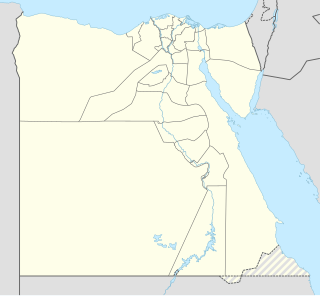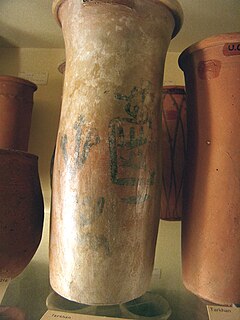Related Research Articles

Saqqara, also spelled Sakkara or Saccara in English, is a vast, ancient burial ground in Egypt, serving as the necropolis for the ancient Egyptian capital, Memphis. Saqqara features numerous pyramids, including the world-famous Step pyramid of Djoser, sometimes referred to as the Step Tomb due to its rectangular base, as well as a number of mastaba tombs. Located some 30 km (19 mi) south of modern-day Cairo, Saqqara covers an area of around 7 by 1.5 km.

Khasekhemwy was the last Pharaoh of the Second Dynasty of Egypt. Little is known about him, other than that he led several significant military campaigns and built the mudbrick fort known as Shunet El Zebib.

Abusir is the name given to an Egyptian archaeological locality – specifically, an extensive necropolis of the Old Kingdom period, together with later additions – in the vicinity of the modern capital Cairo. The name is also that of a neighbouring village in the Nile Valley, whence the site takes its name. Abusir is located several kilometres north of Saqqara and, like it, served as one of the main elite cemeteries for the ancient Egyptian capital city of Memphis. Several other villages in northern and southern Egypt are named Abusir or Busiri. Abusir is one relatively small segment of the extensive "pyramid field" that extends from north of Giza to below Saqqara. The locality of Abusir took its turn as the focus of the prestigious western burial rites operating out of the then-capital of Memphis during the Old Kingdom 5th Dynasty. As an elite cemetery, neighbouring Giza had by then "filled up" with the massive pyramids and other monuments of the 4th Dynasty, leading the 5th Dynasty pharaohs to seek sites elsewhere for their own funerary monuments.

Umm El Qaʻāb is a necropolis of the Early Dynastic Period kings at Abydos, Egypt. Its modern name means "Mother of Pots" as the whole area is littered with the broken pot shards of offerings made in earlier times. The cultic ancient name of the area was (w-)pkr or (rꜣ-)pkr "District of the pkr[-tree]" or "Opening of the pkr[-tree]", belonging to tꜣ-dsr "the secluded/cleared land" (necropolis) or crk-hh "Binding of Eternity".

The necropolis of Draʻ Abu el-Naga' is located on the West Bank of the Nile at Thebes, Egypt, just by the entrance of the dry bay that leads up to Deir el-Bahari and north of the necropolis of el-Assasif. The necropolis is located near the Valley of the Kings.

El-Tarif is a necropolis on the West Bank of the Nile, at the site of ancient Thebes (Luxor), Egypt. It is located in the northwestern outskirts of Luxor and southeast of the Valley of the Kings, opposite Karnak, just to the southwest of the modern village of At-Tarif. It is the oldest of West Thebes' necropolises. It is a small mortuary temple, and the farthest north of the Tombs of the Nobles, and contains tombs of the late First Intermediate Period, Second Intermediate Period and early Middle Kingdom. Old Kingdom mastabas are possibly attributed to local rulers of the Fourth or Fifth Dynasty. Eleventh Dynasty tombs of local rulers have also been noted in the form of a series of rock-cut tombs dated to 2061-2010 B.C.E, the largest of which are Intef I to Intef III, who were kings of this dynasty.

Tomb KV45 is an ancient Egyptian tomb. Located in the Valley of the Kings in Egypt, it was used for the burial of the noble Userhet of the Eighteenth Dynasty.

Tomb KV28 is an ancient Egyptian tomb located in the Valley of the Kings in the Theban Necropolis in Upper Egypt. It was first excavated by persons unknown, and the recent excavations by Donald P. Ryan have found many damaged items from two individuals, possibly nobles of the nearby tomb of Thutmose IV.

Tomb KV29 is an ancient Egyptian tomb in the Valley of the Kings, located in the Theban Necropolis in Egypt.

The Valley of the Kings, also known as the Valley of the Gates of the Kings, is a valley in Egypt where, for a period of nearly 500 years from the 16th to 11th century BC, rock-cut tombs were excavated for the pharaohs and powerful nobles of the New Kingdom.

Ka, also (alternatively) Sekhen, was a Predynastic pharaoh of Upper Egypt belonging to Dynasty 0. He probably reigned during the first half of the 32nd century BC. The length of his reign is unknown.

Nakht was an ancient Egyptian official who held the position of a scribe and astronomer of Amun, probably during the reign of Thutmose IV of the Eighteenth Dynasty. He is buried in the Theban Necropolis in tomb TT52.

A necropolis is a large, designed cemetery with elaborate tomb monuments. The name stems from the Ancient Greek νεκρόπολις nekropolis, literally meaning "city of the dead".

A rock-cut tomb is a burial chamber that is cut into an existing, naturally occurring rock formation, so a type of rock-cut architecture. They are usually cut into a cliff or sloping rock face, but may go down from fairly flat ground. It was a common form of burial for the wealthy in ancient times in several parts of the world.
Persenet was an ancient Egyptian queen consort of the 4th Dynasty. She may have been a daughter of King Khufu and a wife of King Khafra. She is mainly known from her tomb at Giza.
The Memphite Necropolis is an ancient Egyptian necropolis located in the city of Memphis, Lower Egypt. It includes the sites of Giza, Saqqara and Dahshur. Most of the pyramids of the Old Kingdom were built here, along with many mastabas and other tombs.

Woseribre Senebkay was an ancient Egyptian pharaoh during the Second Intermediate Period. The discovery of his tomb in January 2014 supports the existence of an independent Abydos Dynasty, contemporary with the Fifteenth and Sixteenth Dynasties during the Second Intermediate Period. He might also appear in the Turin Canon, where there appear two kings with the throne name "Weser... re". A further possible object with his name is a magical wand bearing the name Sebkay. The wand was found at Abydos but could refer to one or possibly two kings of the earlier 13th Dynasty. The existence of the so-called Abydos Dynasty was first proposed by Detlef Franke and later further developed by Kim Ryholt in 1997.
The Theban Tomb C.8 is an ancient Egyptian tomb in Thebes, Upper Egypt. It is located in Sheikh Abd el-Qurna, part of the Theban Necropolis on the west bank of the Nile opposite Luxor. It is the burial place of the ancient Egyptian Nakht, who was the Overseer of the fowl-houses in the Estate of Amun.
References
- ↑ Porter, Bertha & Moss, Rosalind L.B. (1994). Topographical Bibliography of Ancient Egyptian Hieroglyphic Texts, Reliefs and Paintings: The Theban Necropolis v. 1 - Part 1, Private Tombs. Griffith Institute.
| This Ancient Egypt biographical article is a stub. You can help Wikipedia by expanding it. |